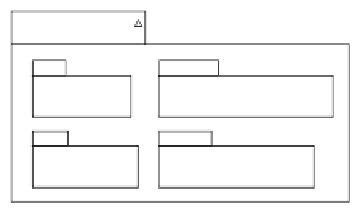Information Technology Reference
In-Depth Information
(such as the TransactionMgr; remember that the computational specification
stated that transaction transparency was required).
The distribution of the engineering objects is described by the elements
of the ObjectDistribution package, which defines seven nodes and seven chan-
nels. Some of these elements are represented in figure A.13, which provides an
overview of the distribution of the main system processing elements. Nodes
contain capsules and clusters that represent groupings of elements for pro-
tection and migration management purposes, according to the policies and
strategies defined for the system.
Finally, the engineering specification also provides the elements needed to
represent the internal elements of channels, as was discussed in chapter 5,
where figure 5.3 showed the architecture of one of the channels of the appli-
cation. The rest of the channels follow a similar pattern.
A.5
Technology Viewpoint Specifications
The technology specifications focus on four main issues: (1) identifying the
main types of technology objects used to implement the system; (2) describ-
ing the requirements on these objects in terms of implementable standards;
(3) stating the extra information for testing (IXIT) that needs to be associ-
ated with the technology objects; and (4) describing the relevant processes and
activities involved in the provision, deployment, maintenance and evolution
of the systems and its parts. In our example, the technology specifications
are structured accordingly, with packages for each of these descriptions (see
gure A.14).
The contents of these packages have already been described in chapter 6,
in figures 6.1, 6.2, 6.3 and 6.4, respectively.
«Technology_Spec»
PhoneMob (T_Spec)
TV_Objects
ImplementableStandards
IXIT
TechnologyProcesses
FIGURE A.14: The overall structure of the technology specification.









